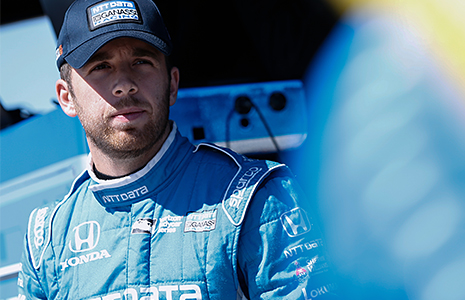Chip Ganassi may joke that Ed Jones isn't at the level that Juan Pablo Montoya, the 1999 Indy car champion for Ganassi’s team, was “going out on cold tires or anything yet.”
Nevertheless, Ganassi holds high hopes for his new young driver.
Part of Chip Ganassi Racing's long-term plan when it selected a driver for the No. 10 NTT DATA Honda this season – to run alongside four-time Verizon IndyCar Series champion Scott Dixon in the No. 9 PNC Bank Honda – was to hire a rising star ready to grow into a leadership role.
“I think he's going to make a step,” Ganassi said of Jones, the 2017 Sunoco Rookie of the Year driving for Dale Coyne Racing, who finished eighth in his Ganassi debut at the Firestone Grand Prix of St. Petersburg on March 11.
“He is as calm as can be on the radio; that's what I like about him,” Ganassi added. “He's very matter of fact and doesn't seem to be bothered. You ask him to do something and he does it. He goes out and the times come down every lap.”
Montoya, known for his extraordinary combination of bravery and skill from the time he stepped into an Indy car, raced to 10 wins, one championship and the 2000 Indianapolis 500 crown in two years with Chip Ganassi Racing beginning in 1999. He won a second Indy 500 in 2015 with Team Penske.
While talents like Montoya are “few and far between,” Jones’ potential at age 23 earned the spot at Ganassi over a crop of young drivers under the age of 25. Dixon is 37 but remains in the prime of his career and isn’t going anywhere soon. He’s won at least one race in each of the past 13 seasons – an Indy car record – has only finished out of the top three in the championship once in the past 11 years (sixth in 2016) and has cemented his status as a legend in the sport by closing within one race win of tying Michael Andretti for third on the all-time list.
 For his part, Jones realizes the significance that he could be the heir apparent to Dixon at some point if things work out.
For his part, Jones realizes the significance that he could be the heir apparent to Dixon at some point if things work out.
“It's a very special feeling to be in line to take over the role he has. It's massive for me,” Jones said.
“To be held in that regard is always what you want going through your career. It just makes everything worth it and makes you continue to work even harder at it and try to be better every time. If I can even half match what Scott has done, it would be huge.”
Jones' arrival coincided with CGR condensing from a four-car operation in 2017 to a two-car team this year. It means the team will lean on its two drivers for all the feedback and data it needs to get to the front and stay there.
Coming from a two-car effort last year with Coyne means Jones hasn't noticed much of a difference in the demands and pressures he faces.
“Obviously, for me, I came into the team not knowing anything different. They have much more resources than other teams and we focus on smaller details and it helps out a lot,” said Jones.
“I think we did a pretty good job in the (St. Pete) race. To finish eighth in my first race is a great starting point and gives us something really good to work from, which is all you can really ask for. We know there's lots of improvement to be made and I am excited to see how it progresses over the next few races.”
Ganassi hasn't asked Dixon specifically to mentor his young teammate, but noted that when the team sees that kind of relationship, it's good for everyone involved.
“We work on fostering that environment,” Ganassi said. “I don't know if we sit there and say, 'You need to be friends with him.’
“We've always taken the attitude that we're inclusive as a team in terms of setups and whatever. If the drivers get along, great – if they don't, I don't really care – but I can tell you that we can show you a history that when the drivers do get along, they seem to be further up the grid.”